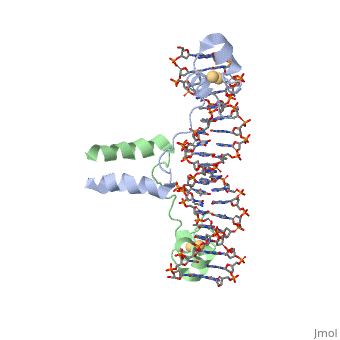While DNA contains all the genetic material in a cell, proteins play an important role in regulating the transcription of DNA to RNA, not to mention replication, repair and packaging.. The interactions between DNA and proteins are important in this process. Most sequence specific interactions occur in the , as the in this groove. In contrast, the contains more of the of DNA.
Helix-Turn-Helix Interactions with DNA
The first DNA binding domain characterized was the helix-turn-helix. In a such as the Cro repressor, two α helices are joined by a turn; there may be additional supporting structures, such as additional helices or beta strands, but this is the basic motif. In most cases, the contributes most to DNA recognition, and hence it is often called the "recognition helix". It binds to the major groove of DNA through a series of hydrogen bonds and various Van der Waals interactions with exposed bases. For example, forms hydrogen bonds with both A219 and A220 of the DNA strand. There are also ionic interactions between basic protein residues, such as , with the backbone phosphate groups. The N-terminal alpha helix stabilizes the interaction between the interaction between protein and DNA, but does not play a particularly strong role in its recognition.[2] The recognition helix and its preceding helix always have the same relative orientation.[
Leucine zippers
Zinc fingers

